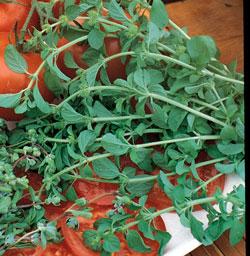
An Unexpected Groundcover
Last year we installed raised beds in our small kitchen garden. We had access to free, HUGE beams and the ability to construct them (thanks, Dad!) so it seemed crazy not to add them. When they went in, we found a use for the mountain of bricks we’ve dug up in our yard. (We “grow” bricks, if nothing else! No idea what they were used for originally or why there are buried in our yard, but we regularly find them anytime we stick a shovel in the dirt.) We laid the bricks as our paths through the raised beds, a charming and functional re purposing of something not designed to rot away to nothing. We didn’t do anything more than embed them in the soil, in an alternating pattern, and they spanned but didn’t quite cover the paths between the beds.
Having a narrow strip of dirt on each side of our paths, we naturally thought about how we might use it. Truthfully, we also wanted to grow something there that would help keep weeds down, too. We landed on thyme, an old standby for cracks and small spaces, which we love equally in appearance and use. It really does a great job in this type of planting, and it smells wonderful when not-so-delicately walked upon, plus it bounces back like nothing has happened. There are a number of easy to find prostrate or creeping thyme varieties that do exceptionally well in situations like this.
Somewhere along the line, though, we also had the idea to try oregano in these tight margins. We purchased a few 3 inch pots and wedged them in to these spaces, between the thymes. I don’t think these were creeping varieties of oregano, because they got a little taller, but I could be wrong. I’m fairly sure that they were chosen without a moment’s thought except, “Why not?”
They were happy, though! They took off, growing up and out without looking back. We had fresh oregano (which also grows in the herb garden, although that’s no reason not to plant it elsewhere,) all season, plus an attractive thicket of its small dark grey-green leaves lining our paths, and, of course, the smell as we regularly trampled it in our passing. It took being sheared without batting an eye and just happily plugged along.
This spring, we decided to remove the bricks from the paths, as our poor preparation had not created a scenario in which they could stay level. They now live in a neat stack back by the chicken yard, waiting for their next assignment. We decided to just heavily mulch the paths instead, which is probably a better option, though not quite as charming. In removing the bricks, we also had to remove the oregano and thyme, which sounds easy but in fact was harder than expected. The oregano, in particular, had formed a large and dense root mat. It was clear that, if we had not removed it, it would have spread far and wide, possibly even overpowering the thyme.
Clearly, oregano can have more uses than simply adding that delightful flavor to your next pizza or Mexican dish. Although I like to think of myself as being fairly knowledgeable about plants, I absolutely love it when a plant surprises me with a little tweak like this. We were not the first to discover this about oregano, of course. A quick internet search will turn up articles about using oregano as a ground cover, or even as a lawn replacement. Somehow, though, it is different when you “discover” it for yourself. All the more reason to take a chance with a plant and see what it has in store for you.




Leave a comment